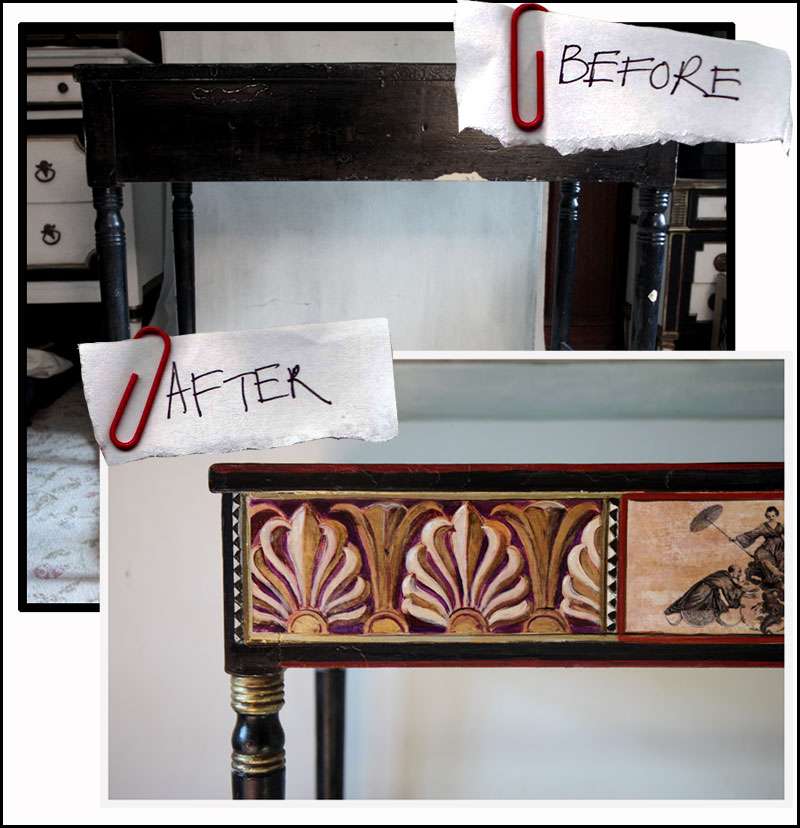S0, you can imagine my surprise when I learned that my dear mother and fellow artist Lydia was embarking on what I was certain would be a decoupage disaster. Fearing that she would forever abandon her paintbrushes for a gluestick, I wondered if some kind of midlife crisis could be implicated.
"NOT decoupage, lacca povera!" So went her adamant mantra. The difference? In theory, there isn't one— the concept is glue and lacquer. Lacca Povera refers to the 18th century, Venetian version of decoupage, later made fashionable and practiced by everyone from Victorian ladies to Lord Byron. However, Google image search tells a different story. Google "decoupage" and all vomitous horrors present themselves to you. Google "lacca povera" and you get something else entirely. As it turns out, lacca povera by any other name just isn't as sweet.

Happy to report that I am eating my words, I'm presenting the project as an (In)Decorous DIY. Considering my own preconceived notions of "decoupage," it's rather appropriate, isn't it?
1. The table, before:

2. The supplies: At a bare minimum you'll need some acrylic paints, a few brushes, a straightedge, shellac (here, both amber colored and clear were used), a foam brush for applying the shellac, and a printout of the design you plan to apply.

3. The design. This one came from a book on chinoiserie. I scanned it and then resized it appropriately before printing it out on ordinary computer paper, with a really awful bubble jet printer. The image should be a graphically simple line drawing in one color. Paint a thin coat of the clear shellac over the design. Let dry. This seals it so you can paint over the image.

4. Using acrylic paints, paint over the designs. Do whatever you want, the sky is the limit— you can even use metallics (metallic gold was used on the shells, for instance). Let dry.

5. The painted papers, taped to the table before being glued. You can take or leave this step.

6. Glue the designs where you want them. Glue stick works well for this purpose because it isn't watery. What you want to avoid are puckers, so smooth over the papers to make sure they lie flat.

7. Add in details with paint. Here, the top of the table was painted, along with borders around the paper cutouts. The borders help blend the paper in with the furniture. This is critical if you don't want an obviously "decoupaged" piece.
8. Finish with a coat (or several) of amber shellac. The amber tone ties the colors together and mutes the colors, contributing to an aged appearance.

One last word of advice: Feel free to experiment. This isn't pastry making, thank god. The Venetians used flour and water paste to attach the designs; we used gluestick. Sometimes it's good to switch things up, right?

7 comments:
WooW! The table looks amazing now! Looks like a real antique furniture!!
thesingular.blogspot.com
This looks fantastic and is certainly a step up from the usual decoupage fare of cherubs playing violins and tizzy bouquets.
unreal! that's wonderful!!
thanks for your sweet comment today.
Joni
The table is absolutely fantastic! Extremely unique and creative.
IF in the market for a book on decoupage projects 'n techniques I highly recommend:
DECORATING WITH PAPER (Creative Looks With Wallpapers, Art Prints, Gift Wrap, and More), by Donna Lang and Lucetia Robertson. Publishers - Clarkson Potter/Publishers New York. It is an excellent resource on the subject.
-Brenda-
LAUREN- why do we never discuss our artistic ventures with one another? I took out a book from our library just last week for inspiration on using paper do do some sort of treatment for one of my bedroom walls. I never got around to actually doing it, but you've inspired me to reconsider. I might need your help so it doesn't end up looking tacky.
Ginger
mrsben- Thank you for your recommendation!
Wow! That could pass as period in the London trade - good job!
Post a Comment